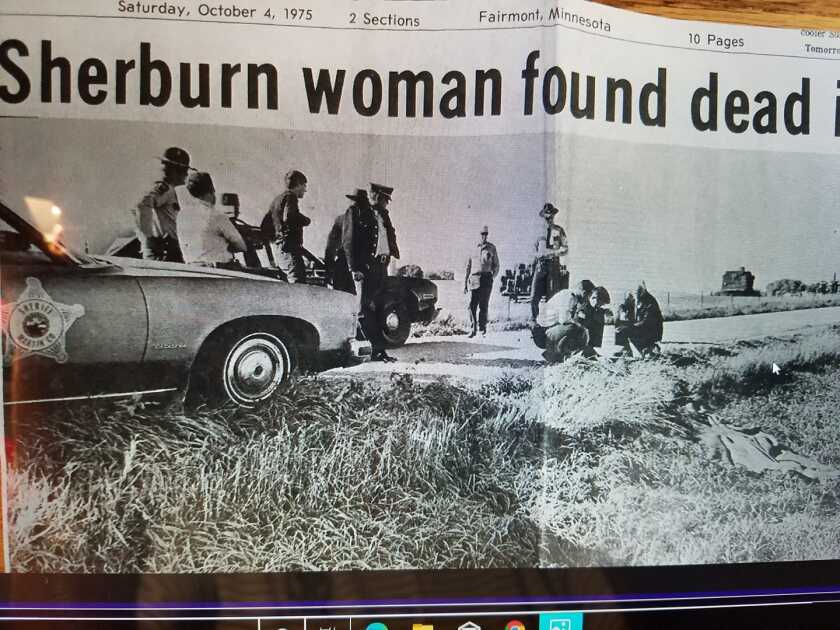MARTIN COUNTY, Minn. ŌĆö A farmerŌĆÖs discovery along a rural gravel road on the morning of Oct. 3, 1975, forever changed the lives of those who loved JoAnn Bontjes.
Bontjes was just 21 years old when her 1974 Vega was found abandoned along Highway 4, five miles north of Sherburn, Minnesota. A passerby discovered her jacket and purse inside the vehicle, with the keys still in the ignition. Her shoes sat neatly on the ground nearby.
ADVERTISEMENT
Almost immediately, a search to find the young salon owner began. Law enforcement scoured the area by land and foot. Yet it was a farmer working in his field who found her body, beaten and bruised with a gunshot wound to the head.
BontjesŌĆÖ death was considered a homicide from the start, yet the Martin County SheriffŌĆÖs Office has never made any arrests related to her death. The case, for years, remained cold ŌĆö until one retired police officer began advocating for justice on BontjesŌĆÖ behalf.

Don Mickelson has spent more than a decade dedicated to independently investigating BontjesŌĆÖ murder case, providing local law enforcement officials with tips along the way.
ŌĆ£IŌĆÖve got two granddaughters,ŌĆØ Mickelson told Forum News Service. ŌĆ£I wouldnŌĆÖt want anybody like that to go through this.ŌĆØ
Those tips have led to DNA testing of a number of suspects and have kept the case in the public eye. The Facebook page, ŌĆ£ ,ŌĆØ managed by Mickelson, has generated more than 3,500 followers eager for answers.
In April, the Martin County SheriffŌĆÖs Office announced the Minnesota Bureau of Criminal Apprehension has been analyzing newly discovered DNA collected from the area where BontjesŌĆÖ body was found ŌĆö taking this case one step closer to justice.
The night Bontjes went missing
Bontjes spent the night out with friends at the American Legion Bar in Trimont, Minnesota, on Wednesday, Oct. 1, 1975, the evening she went missing.
ADVERTISEMENT
At some point between midnight and 1 a.m., Bontjes got in her vehicle alone and began her 8-mile drive home to Sherburn, where she lived with her parents.
She didnŌĆÖt make it far.
The following morning, a local pharmacist was driving to work when he spotted BontjesŌĆÖ unattended vehicle alongside the shoulder of Highway 4, according to an article from the time in the Fairmont Sentinel.
The pharmacist didnŌĆÖt think much of it until he saw the vehicle again that afternoon on his drive home. He pulled over to take a closer look and discovered a pair of womenŌĆÖs shoes outside the vehicle. Inside, he saw a womanŌĆÖs jacket and purse. The keys were still in the ignition.
The witness recognized the vehicle as belonging to Bontjes. He drove home and called her father, who in turn called the Sherburn Police Department.
The next day ŌĆö Friday, Oct. 3, 1975 ŌĆö the search began.

The search was conducted by air and land throughout the area between Trimont and Sherburn.
ADVERTISEMENT
While law enforcement was scouring the area in hopes of finding Bontjes, a farmer roughly a mile from where her vehicle was found came across a young woman in his field around 3 p.m., 30 hours after she went missing.
The unclothed woman had a gunshot wound to her left temple, along with bruises and abrasions throughout her body. At the time of her discovery, she was believed to have been dead for just six hours, according to
Investigators identified the deceased woman as Bontjes ŌĆö and began their investigation aimed at uncovering who was responsible for her murder and transportation of her body.
A cold case turns warm
The initial investigation into BontjesŌĆÖ murder didnŌĆÖt go far.
Based on the timing of her death, law enforcement determined she wasnŌĆÖt killed immediately near her vehicle. Instead, the evidence pointed toward an abduction that ended in murder.
Tire tracks near the front of her vehicle indicated a car had pulled in front of her, although investigators were not able to definitively say the vehicle belonged to the killer.
Investigators did recover DNA from the area where BontjesŌĆÖ body was found, according to Martin County SheriffŌĆÖs Sgt. Matt Owens, who is handling the case.
ADVERTISEMENT

Owens told Forum News Service the DNA has been sent to the Bureau of Criminal Apprehension, along with at least eight other samples belonging to potential witnesses, a mix of those both alive and deceased.
The samples collected were cross-referenced with the DNA discovered where BontjesŌĆÖ body was found.
No matches were discovered, yet that doesnŌĆÖt rule out those eight individuals as potential suspects.
While the Martin County SheriffŌĆÖs Office will not release the type of DNA obtained from the 1975 crime scene, itŌĆÖs possible the DNA collected near the scene belonged to someone other than BontjesŌĆÖ killer.
The Martin County SheriffŌĆÖs Office will continue to cross-reference additional DNA samples from potential suspects, though.
The DNA obtained from the crime scene is not new. Revelations of its existence made headlines in April following a , but Owens told Forum News Service the media release was intended to set the record straight and put rumors to rest.
ŌĆ£We've been working on this case for a long time,ŌĆØ he said. ŌĆ£This press release was more so to put out some of the fires from some of the finger-pointing and name-calling that has been happening. We've had the DNA for a while now, and we've been testing against it for a while now.ŌĆØ
ADVERTISEMENT
The initial investigation
The overall competency of the initial investigation is a factor in BontjesŌĆÖ unsolved case.
Tire tracks discovered near her vehicle were not analyzed, and itŌĆÖs not clear what items were taken into evidence. There are concerns about whether the crime scene ŌĆö where her body was discovered ŌĆö was secured from potential evidence disturbance.
ŌĆ£I think the crime scene got really messed up right away,ŌĆØ Mickelson said. ŌĆ£They had too many people coming and going in the area and on that gravel road and a lot of people there. A lot of deputies, a lot of police. I don't think the area was protected well enough.ŌĆØ

MickelsonŌĆÖs interest in the case stemmed from his passion for law enforcementŌĆÖs role in solving crimes affecting their communities ŌĆö no matter how many years have passed.
ŌĆ£I just felt there was a lack of someone doing their job,ŌĆØ he said. ŌĆ£I've been chief of police. I was in law enforcement for 32 years here, and chief of police for 22 years, and I just felt that someone's not doing their job.ŌĆØ
Mickelson has a theory about what happened on the evening of Wednesday, Oct. 1, 1975, and the early hours of the next morning ŌĆö and he wonŌĆÖt stop his quest for justice until investigations are exhausted on those he feels could be responsible.
ŌĆ£I thought something was covered up some, something or somewhere,ŌĆØ he said. ŌĆ£They thought it was somebody from out of state or somebody passing through. I said, ŌĆśNo, that's not a passing-through kind of thing.ŌĆÖ That's a local murder. Someone, locally, killed that girl and dumped that body there.ŌĆØ
ADVERTISEMENT
The Martin County SheriffŌĆÖs Office is actively investigating BontjesŌĆÖ murder, and will continue to test for DNA samples and follow leads.
Meanwhile, Mickelson will be there as a watchdog, ensuring all potential leads received on his end are fully investigated ŌĆö because he feels justice is just around the corner.
Information about the murder of JoAnn Bontjes can be provided to Martin County SheriffŌĆÖs Office Sgt. Matt Owens at 507- 238-6167.













